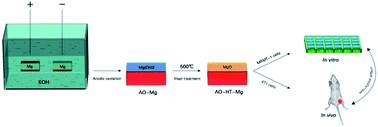On the antitumor properties of biomedical magnesium metal
Abstract
H2 is a therapeutic agent for tumors because it could scavenge free radicals, which is one of the causes for this disease in the human body. Biomedical magnesium (Mg) could release H2 in the biodegradation process, thus it might have antitumor properties. In this study, Mg metal (P-Mg) was subjected to anodic oxidation plus heat treatment to get AO-HT-Mg covered with MgO. In SBF experiments AO-HT-Mg showed bioactivity as it could induce calcium phosphate deposition. The MgO layer played a protective role in the biodegradation process and controlled the H2 releasing rate. In MRMT-1 rat breast carcinoma cell culture experiments, both P-Mg and AO-HT-Mg could inhibit free radical expression in the cells, and AO-HT-Mg showed higher inhibiting ability. In the animal experiments with 72 mice divided into 4 groups, both P-Mg and AO-HT-Mg could inhibit tumor growth. After implantation in the animals, P-Mg showed higher inhibiting ability at the initial stage, and AO-HT-Mg showed higher inhibiting ability after 26 days. The tumor inhibiting properties depended on H2 releasing rates. The results confirm Mg metal has antitumor properties in vivo, and it is possible to optimize its antitumor properties by surface modification.


 Please wait while we load your content...
Please wait while we load your content...